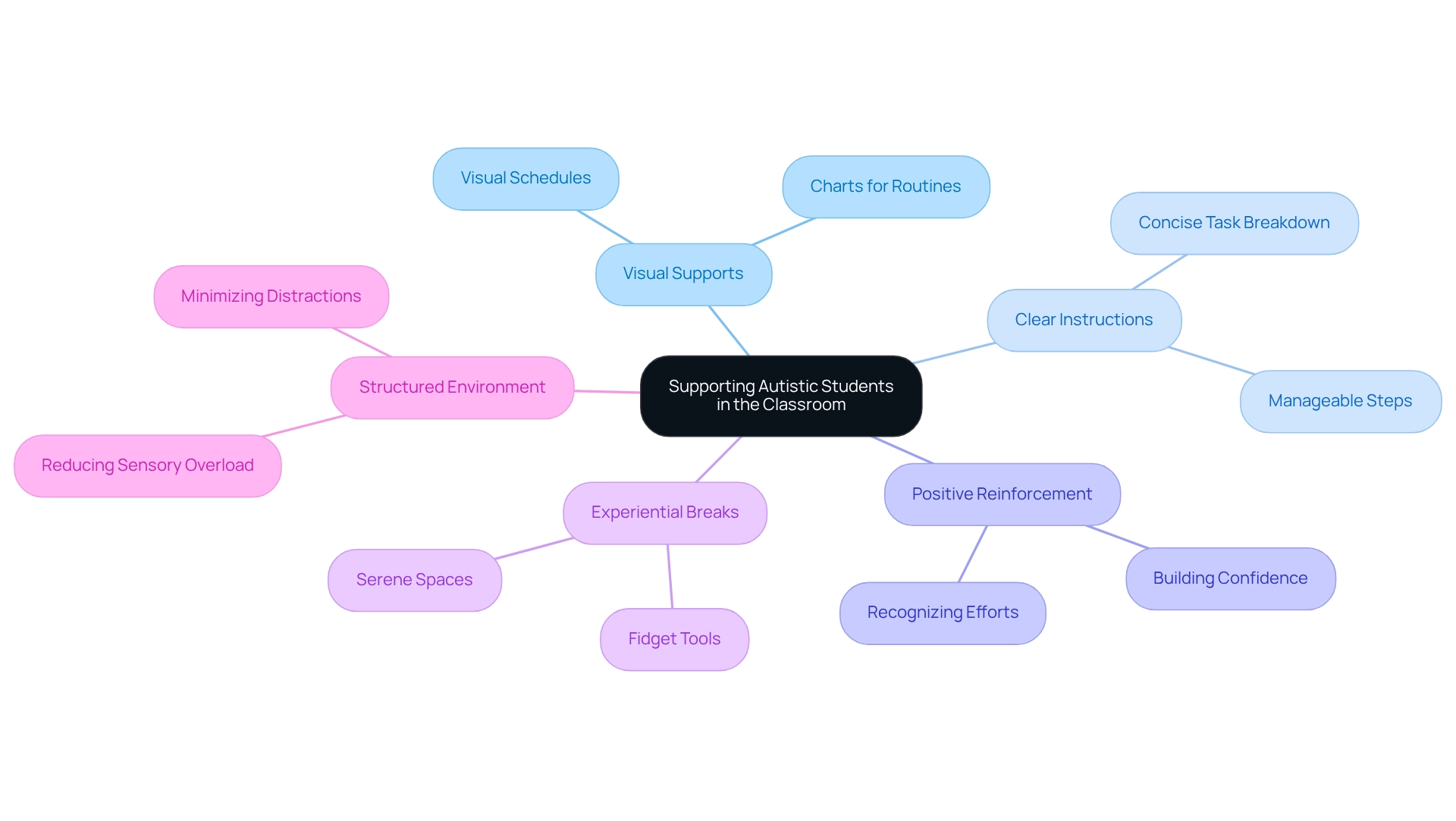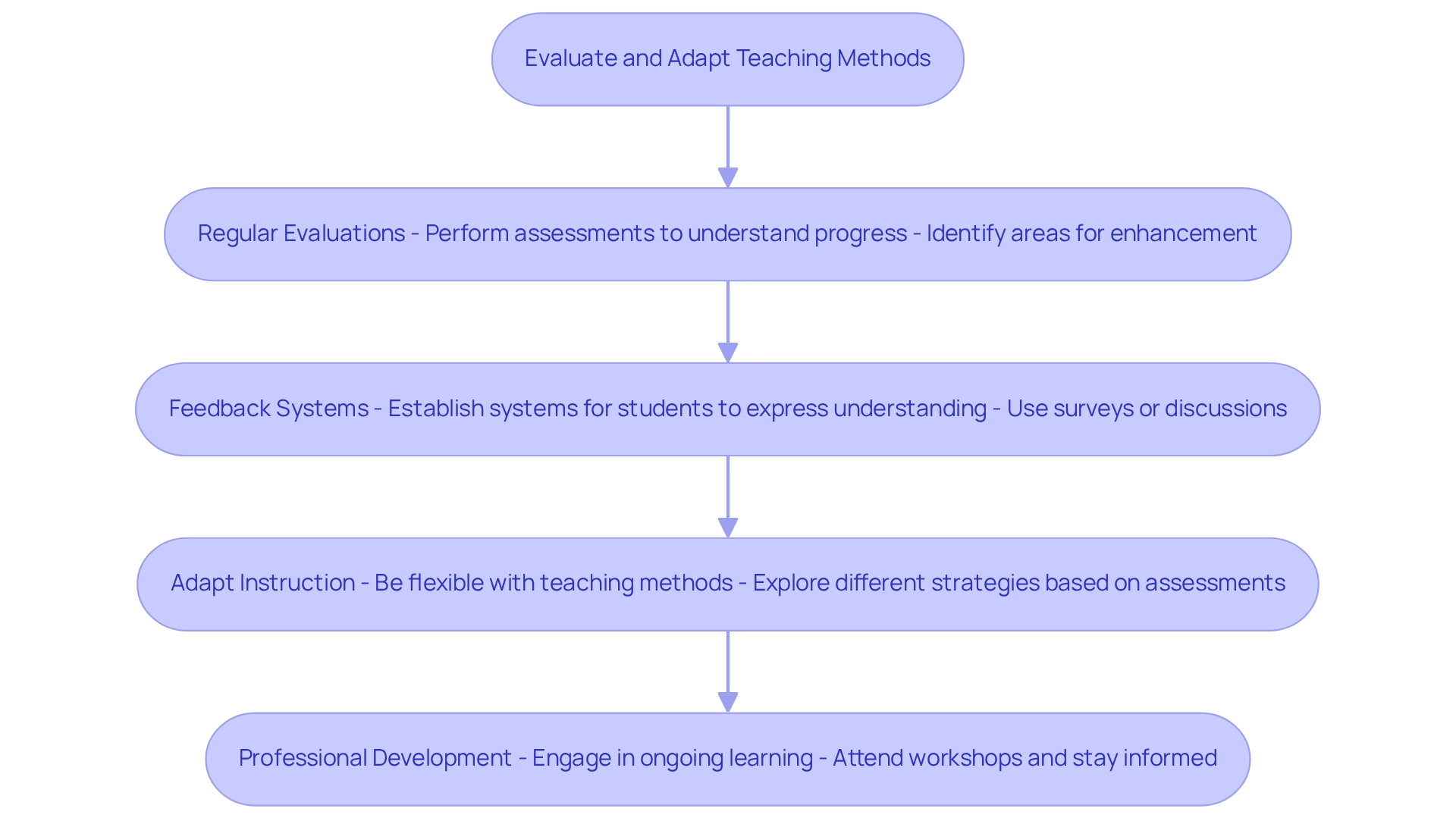Overview
Supporting a child with autism in the classroom is a heartfelt endeavor that requires structured strategies. By implementing:
- Visual supports
- Providing clear instructions
- Using positive reinforcement
Educators can create a nurturing learning environment that truly caters to the needs of these students. It's essential to recognize the unique challenges that autistic children face. Understanding these challenges, alongside collaboration with parents and specialists, can significantly enhance their educational experience and overall development. Together, we can foster a supportive atmosphere that encourages growth and learning.
Introduction
Navigating the complexities of Autism Spectrum Disorder (ASD) in educational settings presents both challenges and opportunities for educators. As awareness of ASD grows, it becomes increasingly crucial for teachers to understand its impact on communication, interaction, and learning.
By recognizing the unique needs of autistic students—such as their sensitivity to sensory input and preference for structured environments—educators can create supportive and inclusive classrooms.
This article delves into effective strategies, collaboration techniques, and adaptive teaching methods that empower educators to foster a nurturing learning atmosphere for all students, particularly those on the autism spectrum.
Understand Autism Spectrum Disorder and Its Impact on Learning
Autism Spectrum Disorder (ASD) is a complex neurodevelopmental condition that significantly influences how individuals communicate, interact, and learn. For many children with ASD, social communication, sensory experiences, and behavior regulation can present unique challenges. It's essential for educators to understand how to support a child with autism in the classroom. For example, many autistic learners may find changes in routine particularly difficult, highlighting the importance of a structured and predictable classroom environment.
Additionally, sensory sensitivities can impact their ability to concentrate. Being mindful of how to support a child with autism in the classroom can greatly contribute to creating a supportive learning atmosphere. Familiarizing yourself with the characteristics of ASD, such as challenges in interpreting social cues and the necessity for clear, concrete instructions, is crucial. This knowledge empowers you to tailor your teaching methods on how to support a child with autism in the classroom, creating an environment where all learners can thrive.

Implement Classroom Strategies for Supporting Autistic Students
Thoughtful strategies on how to support a child with autism in the classroom are essential for making a significant difference in the learning experience of autistic students. By implementing these approaches, you can create a nurturing environment that fosters understanding and growth.
-
Visual Supports: Imagine how comforting it can be for a student to see their day laid out visually. Utilizing visual schedules and charts can help learners grasp daily routines and expectations, reducing anxiety and enhancing comprehension.
-
Clear Instructions: Think about the clarity that simple, concise instructions can bring. By breaking tasks into smaller, manageable steps, you can prevent overwhelming learners and help them feel more secure in their abilities.
-
Positive Reinforcement: Consider the power of encouragement. By recognizing and rewarding efforts—no matter how small—you can build confidence and motivation in your students, fostering a positive learning environment.
-
Experiential Breaks: Picture a student taking a moment to regroup. Incorporating experiential breaks into the daily schedule allows learners to engage in soothing activities, such as using fidget tools or spending time in a serene space, which aids in self-regulation.
-
Structured Environment: Envision a classroom designed for focus. Organizing the space to minimize distractions and reduce sensory overload creates a calm learning atmosphere where students can thrive.
By embracing these strategies, you can discover how to support a child with autism in the classroom, making a profound impact on their educational journey and nurturing their potential.

Collaborate with Parents and Specialists for Comprehensive Support
Effective collaboration involves understanding how to support a child with autism in the classroom through open communication with parents and specialists, fostering a supportive environment for every child. Here are some thoughtful steps to enhance this vital partnership:
-
First, consider establishing regular check-ins with parents. These meetings can be a wonderful opportunity to discuss their child's progress and any concerns that may arise. Utilizing various communication methods—such as emails, phone calls, or in-person meetings—ensures that parents feel accessible and involved in their child's journey.
-
Next, it's essential to involve specialists in this process. Collaborating with special education teachers, therapists, and other professionals is essential for learning how to support a child with autism in the classroom by providing valuable insights and strategies tailored specifically to meet the child's unique needs. Their expertise can illuminate paths that may not be immediately visible to parents.
-
Additionally, sharing resources with parents can empower them to support their child at home. Providing tools and strategies on how to support a child with autism in the classroom can make a significant difference in managing challenging behaviors or enhancing social skills. This sharing of knowledge fosters a sense of teamwork and partnership.
-
Finally, understanding how to support a child with autism in the classroom is paramount for creating an inclusive classroom environment. Encouraging parents to share their child's interests and strengths not only values diversity but also fosters a deep sense of belonging. Together, we can cultivate a space where every child feels respected and valued.

Evaluate and Adapt Teaching Methods for Individual Needs
To ensure that your teaching methods are effective for autistic students, it’s important to know how to support a child with autism in the classroom with care and understanding. Here are some thoughtful strategies to consider:
-
Regular Evaluations: Performing regular evaluations is essential. These assessments help you understand each student's progress and identify areas that may need enhancement. By using both formal and informal assessments, you can gather comprehensive data that truly reflects their learning journey.
-
Feedback Systems: Establishing feedback systems allows learners to express their understanding and emotions regarding their educational experiences. This could be through surveys or one-on-one discussions, fostering an environment where students feel heard and valued.
-
Adapt Instruction: Be open to adapting your instruction based on the assessment results. If a particular method isn’t resonating, it’s perfectly okay to explore different strategies that better align with the learner's unique style. Flexibility is key in creating a supportive learning atmosphere.
-
Professional Development: Engaging in ongoing professional development is vital. Staying informed about the latest research and strategies for supporting autistic students can significantly enhance your teaching. Consider attending workshops, webinars, or conferences to continually grow your skills and knowledge.
By implementing these strategies, you can create a nurturing educational experience that illustrates how to support a child with autism in the classroom during their learning journey.

Conclusion
Creating an inclusive educational environment for students with Autism Spectrum Disorder (ASD) presents both challenges and opportunities for educators. By embracing the unique characteristics of ASD—such as communication difficulties and sensory sensitivities—teachers can craft tailored strategies that cater to the diverse needs of their students. Implementing visual supports, providing clear instructions, and utilizing positive reinforcement are just a few effective classroom strategies that can significantly enhance the learning experiences for autistic students.
Collaboration with parents and specialists is equally essential in nurturing a supportive atmosphere. Regular communication and resource sharing between educators and families can bridge gaps, fostering a unified approach to addressing individual needs. Moreover, involving specialists ensures that students benefit from a comprehensive support system, transforming the classroom into a more inclusive environment.
Additionally, ongoing evaluation and adaptation of teaching methods are crucial. By consistently assessing student progress and welcoming feedback, educators can refine their approaches to align more closely with the learning styles of autistic students. Engaging in professional development empowers teachers to stay current with effective practices, ultimately leading to improved educational outcomes.
In summary, fostering an inclusive classroom for students with ASD requires a multifaceted approach that combines understanding, effective strategies, collaboration, and continuous improvement. By prioritizing these elements, educators can create nurturing environments where all students can thrive. Let us come together to support one another in this vital journey.
Frequently Asked Questions
What is Autism Spectrum Disorder (ASD)?
Autism Spectrum Disorder (ASD) is a complex neurodevelopmental condition that affects how individuals communicate, interact, and learn.
What challenges do children with ASD face in learning?
Children with ASD often experience challenges in social communication, sensory experiences, and behavior regulation, which can impact their learning.
Why is a structured classroom environment important for autistic learners?
A structured and predictable classroom environment is important because many autistic learners find changes in routine particularly difficult.
How do sensory sensitivities affect children with ASD in the classroom?
Sensory sensitivities can impact an autistic child's ability to concentrate, making it essential to create a supportive learning atmosphere.
What should educators understand about the characteristics of ASD?
Educators should understand that children with ASD may struggle with interpreting social cues and require clear, concrete instructions.
How can educators tailor their teaching methods for students with ASD?
By familiarizing themselves with the characteristics of ASD, educators can adjust their teaching methods to better support autistic learners, creating an environment where all students can thrive.




